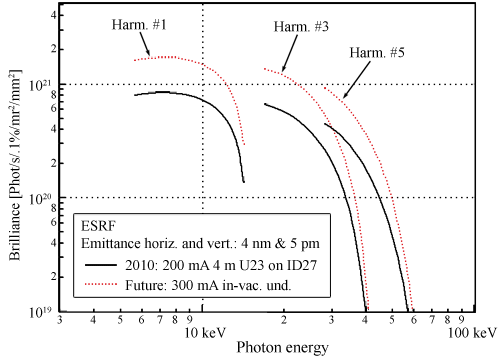- Home
- News
- Spotlight on Science
- Record brilliance...
Record brilliance at the ESRF achieved thanks to ultra small vertical emittance
06-09-2010
Within the ESRF Upgrade Programmme, the Accelerator Division has increased the brilliance and coherence of the undulator-generated photon beams through a reduction of the electron beam vertical emittance by a factor of six. A value of 5 picometres is now available in User Service Mode, making possible photon beam brilliance values matched nowhere else in the world.
Share
The 224 electron beam position monitors in the ESRF storage ring have recently been upgraded by replacing their electronics by more modern units that make use of digital electronics (Libera [1]). The new system provides much improved resolution in the orbit measurement which now makes it possible to measure the lattice functions of the ring (beta functions) with higher accuracy. The greater precision combined with an improved algorithm for the coupling correction has resulted in the operation of the ring in User Service Mode with a vertical emittance (rms) as small as 5 pm for several days in a row. This corresponds to a normalised emittance (rms) of 0.06 mm mrad. The emittance of the beam is measured continuously by various diagnostic tools located around the storage ring (2 pinhole cameras and 11 beam size monitors on bending magnets for X-rays around 170 keV). With such a small vertical emittance, the vertical size of the electron beam inside an undulator is as low as 9 micrometres (Full Width at Half Maximum, FWHM), while the vertical divergence is 3 microradians (FWHM). The coherence and the brilliance of the photon beam has therefore reached record values, which are shown in Figure 1.
Experiments making use of the X-ray beam coherence or needing a small X-ray spot size on the sample will strongly benefit from such a beam provided that the beamline optics is carefully designed to preserve the emittance. Particular attention must be paid to the reflective optics (slope errors) and the generation of small-angle scattering by windows and filters must be avoided. Ultra-high vacuum type beamlines (no windows) equipped with Fresnel refractive lenses and/or zone plates should be able to make full use of a photon beam with such a small emittance. Reducing the vertical emittance from 30 to 5 pm reduces the lifetime of the stored electron beam from 50 to 35 hours due to higher intra-bunch scattering between electrons (Touschek effect). The number of injections per day has been increased to compensate for the shorter beam lifetime.
To obtain such a low emittance value, the coupling between the horizontal and vertical betatron oscillation has been recorded and corrected by means of 32 skew quadrupoles located along the ring circumference. Unfortunately, some of the present 72 undulator segments have residual skew quadrupole errors which vary with the magnetic gap. As a result, when the beamline users vary the gap, the coupling correction degrades and the vertical emittance changes with time. It is not yet possible to keep the ultra-small emittance values for more than a few days without a new correction of the lattice, but it is planned to improve on this issue by measuring and locally correcting the skew quadrupoles field changes in order to maintain the low emittance for weeks without any global correction. Simulations predict that a smaller vertical emittance can also be reached by increasing the number of skew quadrupole corrections along the ring circumference.
An even higher brilliance that will extend to the 1021 region is within reach (shown in Figure 1). Longer straight sections (6 and 7 m) are being implemented as part of the Upgrade Programme. They will allow the length of in-vacuum undulators to be increased to 5 m. Additionally, the storage ring could be operated at 300 mA during User Service Mode, which has been demonstrated by tests in Machine Dedicated Time during 2010. A further improvement could also come from equipping a long straight section with cryogenic undulators. Reaching such levels of performance is essentially linked to the availability of the necessary financial resources and no longer limited by technical issues.
References
[1] Libera Electronics produced by Instrumentation Technologies (Slovenia); http://www.i-tech.si/
Authors
P. Elleaume and L. Farvacque on behalf of the ESRF Accelerator Division
Top image: Electron beam distribution in a bending magnet of the storage ring in the transverse plane during User Service Mode following reduction of the vertical emittance. Representative image taken by the X-ray pinhole camera system.




